
San Michele in Borgo is a Roman Catholic church in Pisa, region of Tuscany, Italy.

San Michele in Borgo is a Roman Catholic church in Pisa, region of Tuscany, Italy.
The church, together with the monastery (which first belonged to the Benedictines and, from the 12th century, the Camaldolese) was built in the late 10th to early 11th century outside the city's walls, over an ancient temple dedicated to Mars. [1] Both were restored several times in the following ages.
The façade is from the 14th century. The upper part has three orders of typically Pisane Gothic loggias. There are three portals in Gothic style and withlunettes; the main one is surmounted by a tabernacle with "Madonna and Child" by Lupo di Francesco (the original is in the National Museum of San Matteo in Pisa).
The solemn interior, with a nave and two aisles, houses a Crucifix attributed to Nino Pisano (14th century), paintings by Matteo Rosselli, Baccio Lomi, Aurelio Lomi, and Giuseppe Melani, as well as remains of frescoes from the 13th century. Under the pavement is the crypt, probably what remains of a former church.

Pisa is a city and comune in Tuscany, central Italy, straddling the Arno just before it empties into the Ligurian Sea. It is the capital city of the Province of Pisa. Although Pisa is known worldwide for its leaning tower, the city contains more than twenty other historic churches, several medieval palaces, and bridges across the Arno. Much of the city's architecture was financed from its history as one of the Italian maritime republics.

The province of Lucca is a province in the Tuscany region of Italy. Its capital is the city of Lucca.
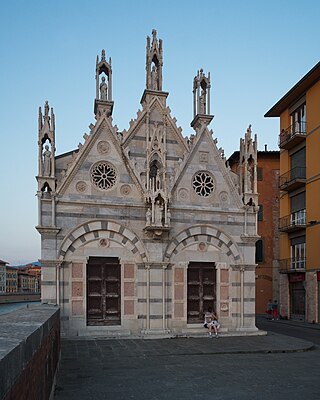
Santa Maria della Spina is a small church in the Italian city of Pisa. The church, erected around 1230 in the Pisan Gothic style, and enlarged after 1325, was originally known as Santa Maria di Pontenovo for the newer bridge that existed nearby, collapsed in the 15th century, and was never rebuilt.

Poggibonsi is a town in the province of Siena, Tuscany, central Italy. It is located on the River Elsa and is the main centre of the Valdelsa Valley.

Castelfiorentino is a city and comune (municipality) in the Metropolitan City of Florence, Tuscany, central-northern Italy, halfway between Florence, Pisa (45 km) and Siena (55 km). The population is approximately 20,000 inhabitants. It is part of Valdelsa. Castelfiorentino borders the following municipalities: Certaldo, Empoli, Gambassi Terme, Montaione, Montespertoli and San Miniato.
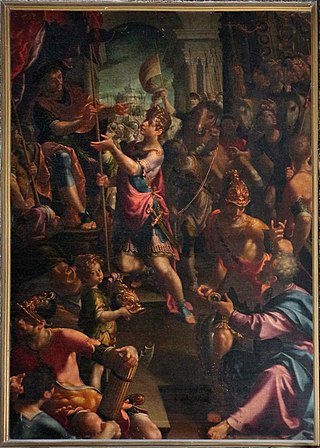
Aurelio Lomi was an Italian painter of the late-Renaissance and early-Baroque periods, active mainly in his native town of Pisa, Tuscany.

San Frediano is a Romanesque-style Roman Catholic church in Pisa, Tuscany, Italy. It now functions as the official church of the University of Pisa.
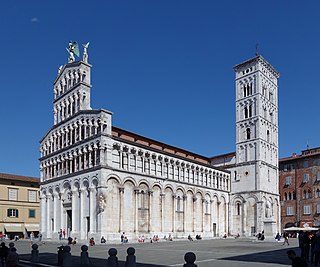
San Michele in Foro is a Roman Catholic basilica church in Lucca, Tuscany, central Italy, built over the ancient Roman forum. Until 1370 it was the seat of the Consiglio Maggiore, the commune's most important assembly. It is dedicated to Archangel Michael.

San Piero a Grado is a church in Pisa, Tuscany, Italy, in the eponymous frazione 7 kilometres (4.3 mi) west of the city center. The church is located where once was a now disappeared port of the Pisan Republic, where, according to the legend, St. Peter landed in Italy from Antiochia in 44 AD.
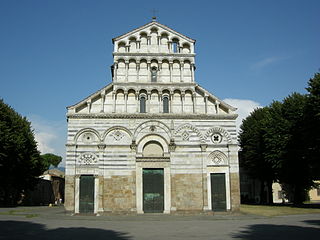
San Paolo a Ripa d'Arno is a Roman Catholic church in Pisa, region of Tuscany, Italy. It is a pre-eminent example of Tuscan Romanesque church architecture. The church is also locally known as Duomo vecchio.

San Nicola is a church in Pisa, Tuscany, Italy.

Santa Caterina d'Alessandria is a Gothic-style Roman Catholic church in Pisa, Tuscany, Italy.

Carrara Cathedral is a Roman Catholic church, dedicated to Saint Andrew, in the town of Carrara, located in central Italy. Most of the exterior, and much of the interior, is covered in the local Carrara marble.

San Francesco is a former Gothic-style Roman-Catholic church and monastery located in Piazza San Francesco in central Lucca, Tuscany, Italy. Since its restoration, it is home to IMT School for Advanced Studies Lucca, a superior graduate school.

San Giovanni Fuoricivitas is a Romanesque religious church and adjacent buildings in Pistoia, Tuscany, central Italy. The adjective fuoricivitas refers to it location, outside of the first set of city walls, when it was founded during the era of Lombard rule in Italy.

San Silvestro is a former church in Pisa, Italy, facing piazza San Silvestro. It is now deconsecrated.

Santa Maria del Carmine is a Roman Catholic church in Pisa, Italy known for its altarpiece.

San Michele degli Scalzi is a church located in Piazza San Michele degli Scalzi, in the eastern part of Pisa, Italy. It had also been known as the church of San Michele degli Scalzi in Orticaia, referring to the swampy nature of the site at the time of its founding. The term Scalzi refers to the barefoot monks linked to the church. Dating back to the 11th century, it has been restored several times in the original Romanesque style.
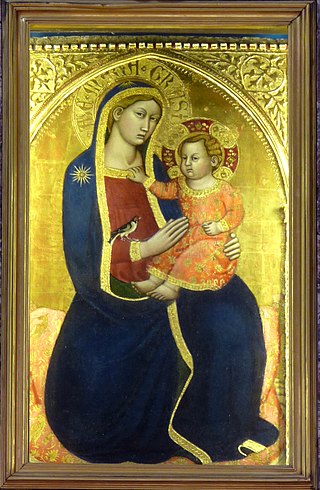
Jacopo di Michele, also called Jacopo Gera, Iacopo di Michele, or Gera da Pisa is a 14th-century painter, active mainly in Pisa and elsewhere in Tuscany, in a Gothic style. His activity is documented from 1361 to 1395. He is the brother of Getto di Jacopo
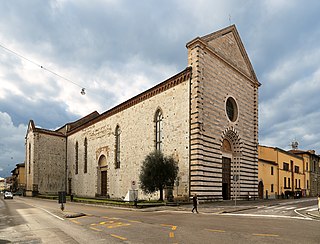
San Francesco is a Gothic-style, Roman Catholic church located on the piazza of the same name in Pistoia, region of Tuscany, Italy.